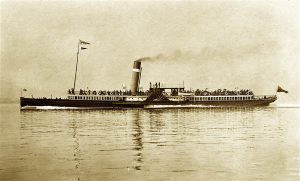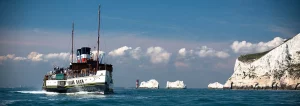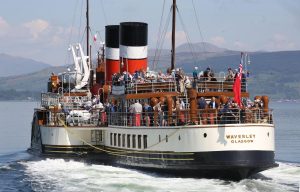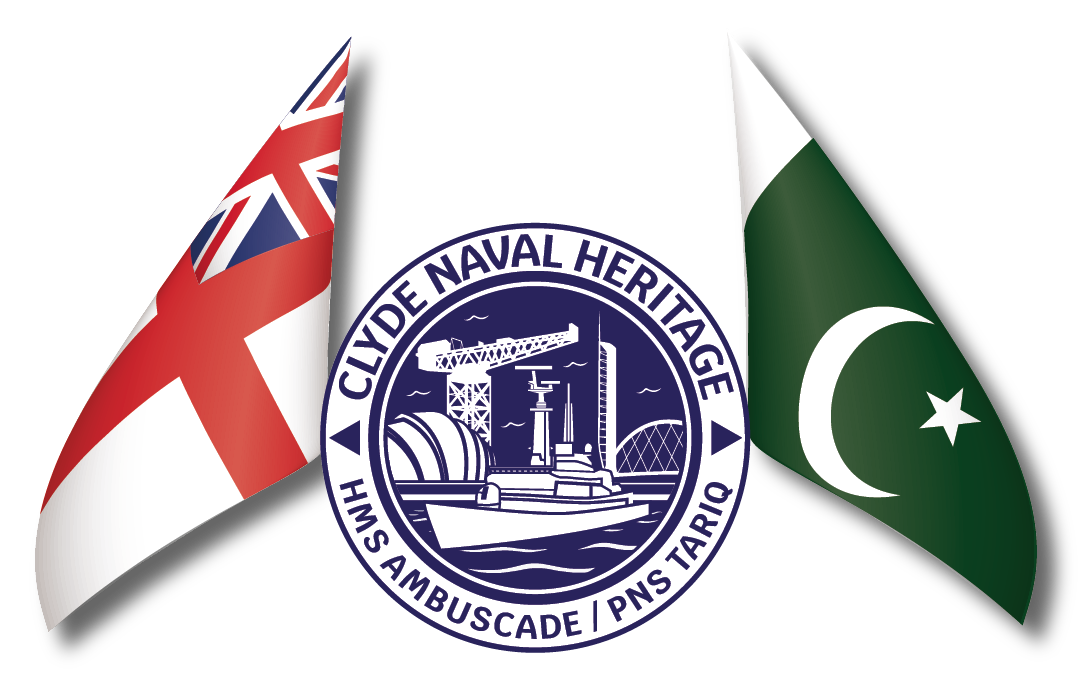The PS Waverley is a historically significant paddle steamer, known as the world’s last sea-going paddle steamer. Launched in 1947, the Waverley holds an iconic place in maritime heritage, offering a fascinating story of resilience, innovation, and restoration. Below is a detailed history of this historic vessel.
Early Origins: The First PS Waverley (1899-1940)
The history of the PS Waverley begins with the original vessel launched in 1899. Built by A. & J. Inglis of Pointhouse, Glasgow, the first Waverley was commissioned by the North British Railway Company for service on the Clyde. It was used to transport passengers between Glasgow and Arrochar, a route that saw the early paddle steamers popular for leisure travel during the industrial era.
This first Waverley had a successful service life until the outbreak of World War II, during which she was requisitioned by the Royal Navy for use as a minesweeper. Tragically, in May 1940, the original Waverley was sunk during the evacuation of Dunkirk as part of the war effort.

The Construction of the Current PS Waverley (1947)
To replace the original Waverley lost in the war, the London and North Eastern Railway (LNER) commissioned the construction of a new paddle steamer. The current PS Waverley was launched on October 2, 1946, and completed in 1947 by the same shipbuilders, A. & J. Inglis, on the Clyde. Her construction was a post-war project aimed at reviving Clyde’s popular leisure cruises, as post-war Britain sought to rebuild its cultural and leisure industries.
The new Waverley was 225 feet long and equipped with a triple-expansion steam engine, a propulsion system powered by coal that turned two paddle wheels on either side of the vessel. This design allowed the Waverley to carry over 900 passengers and return to the Glasgow-Arrochar route, alongside other leisure cruises along the Scottish west coast.
Golden Age of Clyde Steaming (1947-1973)
The Waverley quickly became an integral part of the Clyde steamers, which were a key part of leisure travel in Scotland. During the 1950s and 1960s, she ran regular services from Glasgow, Rothesay, Largs, and Dunoon, becoming one of the most recognizable ships in Scotland.
This era was the golden age of Clyde steamers, with vessels like the Waverley offering scenic routes to holiday destinations around the Firth of Clyde. With post-war travel booming and paddle steamers becoming symbols of recreation, the Waverley attracted locals and tourists alike, often being used for trips around the islands of Arran, Bute, and Cumbrae.
However, the rise of car travel and changes in tourism in the late 1960s started to diminish the demand for these paddle steamers. By the early 1970s, most of the Clyde steamers had been withdrawn from service or scrapped. The Waverley herself faced retirement in 1973.

The Preservation and Restoration of PS Waverley (1974-Present)
Facing the end of her service life in 1973, the Waverley was sold for just £1 to the Waverley Steam Navigation Co., a charity formed by enthusiasts who wanted to preserve this unique ship. This marked the beginning of one of the most successful maritime preservation efforts in history.
With public donations and fundraising efforts, the Waverley underwent her first major refit in 1975, ensuring she could continue to operate. She was upgraded in various stages throughout the late 20th century to meet modern maritime safety standards, while still preserving her historic features like her steam engine and paddle-wheel propulsion system.
2000 Refit
In the late 1990s, it became clear that the Waverley needed more substantial repairs to continue operating. In 2000, a major £7 million Heritage Lottery Fund-supported refit was carried out. This involved overhauling much of the ship’s structure, including renewing her hull and upgrading her machinery. Crucially, the refit maintained the steamer’s classic look, keeping her authentic to her 1940s design while modernizing key systems.

Waverley’s Modern Service and Routes
The Waverley returned to service as a fully operational and historic vessel after her refit in 2003. Today, she operates around the United Kingdom, offering passengers scenic cruises along famous waterways. The Waverley remains based in Scotland but travels throughout Britain during the summer, including to the south coast, Thames River, and the Bristol Channel.
Key regular routes include:
- Clyde River Cruises: The ship’s traditional home, offering voyages around the Firth of Clyde to islands like Arran, Bute, and Cumbrae.
- Thames Cruises: In London, the Waverley has become a highlight for tourists seeking trips down the Thames, including stops at popular spots like Tower Bridge.
- South Coast of England: Cruises from ports like Weymouth and Southampton to locations such as the Isle of Wight.
- Bristol Channel: Trips that explore South Wales and the Severn Estuary, including stops at Penarth and Clevedon.
Significance and Legacy
The PS Waverley is more than just a preserved vessel; she’s a living example of Scotland’s maritime heritage and a symbol of industrial-era travel. As the world’s last sea-going paddle steamer, the Waverley represents the culmination of paddle propulsion technology, which once dominated river and coastal travel. Her continued operation offers the public a chance to experience a mode of travel that has nearly vanished from the world.
The Waverley has gained historic status, and she is part of the UK’s National Historic Fleet, a recognition given to vessels of national significance. She regularly participates in heritage events, and her steam engine, visible to passengers, remains one of her most attractive features.
Challenges and Future Prospects
Despite her success as a tourist attraction, the Waverley faces ongoing challenges. Maintaining and operating a historic ship is costly, and the Waverley has required numerous fundraising campaigns over the years to finance repairs. In 2019, the ship was temporarily taken out of service after her boilers were found to need replacement, resulting in a public appeal that raised over £2.3 million to fund the repairs.
Looking to the future, the Waverley’s operators continue to balance the vessel’s historic preservation with the need to meet modern safety and environmental regulations. The goal remains to keep the Waverley sailing well into the 21st century, ensuring that future generations can experience the wonder of traveling aboard this extraordinary vessel.
The PS Waverley stands as a testament to Scotland’s rich maritime history and the passion of the people who have worked to preserve her. From her origins as a post-war replacement for a lost ship, to her status as the last sea-going paddle steamer, the Waverley has survived changing times and the decline of steam power. Her enduring appeal lies in her unique ability to take passengers on a journey not just across the water, but back in time.
As the world’s only remaining sea-going paddle steamer, the PS Waverley continues to sail, offering an unmatched historical experience and a living link to the golden age of paddle steamers.

